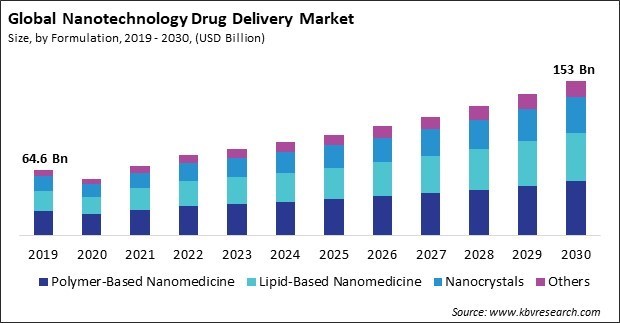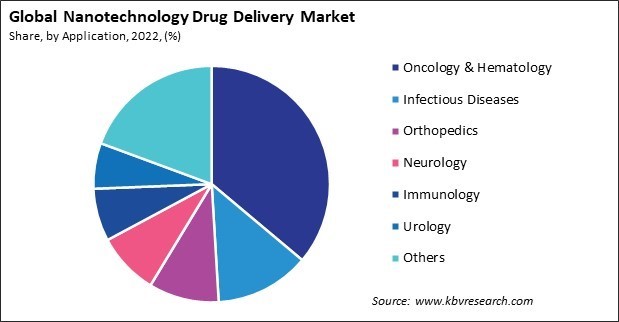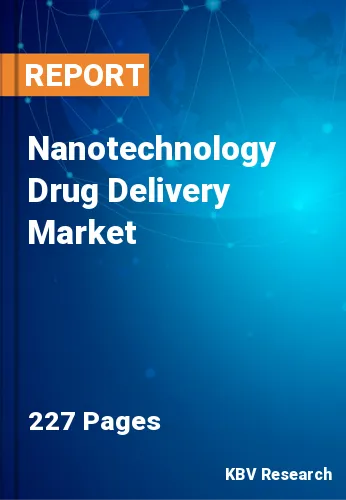“Global Nanotechnology Drug Delivery Market to reach a market value of USD 153 Billion by 2030 growing at a CAGR of 8.7%”
The Global Nanotechnology Drug Delivery Market size is expected to reach $153.0 billion by 2030, rising at a market growth of 8.7% CAGR during the forecast period.
The encapsulation of neuroactive drugs in nanoparticles can enhance their stability, protecting them from enzymatic degradation and ensuring a sustained release profile. Consequently, the neurology segment captured $6,760.5 million revenue in the market in 2022. This improved stability is crucial for maintaining therapeutic drug levels over an extended period, especially in chronic neurological conditions requiring long-term treatment. These aspects will pose lucrative growth prospects for the segment.

Nanoparticles have a high surface area-to-volume ratio compared to larger particles. This characteristic allows for more efficient drug loading on the nanoparticle surface, providing a larger contact area for drug release. Many drugs, especially those with poor water solubility, face challenges in effective delivery. Nanoparticles can encapsulate hydrophobic drugs, improving their solubility and making them more bioavailable. This is particularly important because drug absorption often depends on the drug's ability to dissolve in the body's fluids. Additionally, tailoring nanoparticles to adhere to particular cells, tissues, or organs is possible. This targeted delivery enables drugs to reach the intended site of action more precisely, minimizing exposure to healthy tissues. In traditional drug delivery, systemic circulation can lead to unintended distribution and interaction with healthy cells, causing side effects. This controlled release helps maintain therapeutic drug levels over an extended period, reducing the risk of sudden spikes in drug concentration that may lead to adverse effects. These factors will pose lucrative growth prospects for the market.
Therefore, the early stages of the pandemic, marked by lockdowns, travel restrictions, and disruptions in global supply chains, posed challenges for the market. Many research activities and development projects faced delays due to laboratory closures, restricted access to facilities, and logistical issues in procuring necessary materials. The unique properties of nanoparticles, such as their high surface area and customizable surface functionalities, were explored to develop antiviral coatings, drug delivery systems, and diagnostic tools. Nanotechnology played a role in enhancing therapeutic agents' stability and delivery and improving diagnostic assays' sensitivity and specificity. Therefore, the COVID-19 pandemic moderately impacted the market.
However, developing nanoscale drug delivery systems involves intricate processes, including nanoparticle design, synthesis, and characterization. These processes often require expertise in nanoscience, materials science, and pharmaceutical sciences. The complexity of working at the nanoscale adds to the challenges and costs associated with R&D. Manufacturing nanoscale drug delivery systems often requires specialized equipment and facilities. Setting up and maintaining such facilities can be expensive. Developing novel technologies' inherent uncertainties and risks contribute to the higher costs. Companies investing in this drug delivery need to account for the risk of failure at various stages of development and the potential need for adjustments to research strategies. These factors are expected to restrain the growth of the market.
On the basis of application, the market is divided into oncology & hematology, infectious diseases, orthopedics, neurology, urology, immunology, and others. The oncology and hematology segment recorded the maximum revenue share in the market in 2022. Nanoparticles can be designed to passively target tumor tissues through the enhanced permeability and retention (EPR) effect, exploiting the leaky vasculature characteristic of tumors. Targeted drug delivery is crucial in hematological disorders such as leukemia and lymphoma. By engineering nanoparticles to interact with particular cell types or to traverse the circulation, therapeutic agents can be more efficiently delivered to the affected bone marrow or blood cells. Therefore, the segment will grow rapidly in the coming years.

Based on formulation, the market is segmented into lipid-based nanomedicine, polymer-based nanomedicine, nanocrystals, and others. In 2022, the lipid-based nanomedicine segment garnered a significant revenue share in the market. Lipids are natural components of cell membranes, making lipid-based nanocarriers inherently biocompatible. This characteristic reduces the likelihood of adverse reactions and enhances the safety profile of lipid-based nanomedicines. Biocompatibility is critical, especially in drug delivery, where minimizing toxicity and ensuring patient safety are paramount. These factors will help in the expansion of the segment.
Free Valuable Insights: Global Nanotechnology Drug Delivery Market size to reach USD 153 Billion by 2030
By region, the market is segmented into North America, Europe, Asia Pacific, and LAMEA. The North America segment procured the highest revenue share in the in 2022. North America, particularly the United States, is a global hub for research and development in pharmaceuticals and nanotechnology. The region's leading research institutions, academic centers, and pharmaceutical companies foster innovation and drive advancements in nanotechnology drug delivery. Thus, the segment will grow rapidly in the coming years.
| Report Attribute | Details |
|---|---|
| Market size value in 2022 | USD 79.5 Billion |
| Market size forecast in 2030 | USD 153 Billion |
| Base Year | 2022 |
| Historical Period | 2019 to 2021 |
| Forecast Period | 2023 to 2030 |
| Revenue Growth Rate | CAGR of 8.7% from 2023 to 2030 |
| Number of Pages | 227 |
| Number of Tables | 310 |
| Report coverage | Market Trends, Revenue Estimation and Forecast, Segmentation Analysis, Regional and Country Breakdown, Porter’s 5 Forces Analysis, Company Profiling, Companies Strategic Developments, SWOT Analysis, Winning Imperatives |
| Segments covered | Formulation, Application, Region |
| Country scope |
|
| Companies Included | AbbVie, Inc., Pfizer Inc., Johnson & Johnson (Johnson & Johnson Services, Inc.), Novartis AG, Bristol-Myers Squibb Company, AstraZeneca PLC, Amgen, Inc., Merck KGaA, Teva Pharmaceutical Industries Ltd. and Sanofi S.A |
By Formulation
By Application
By Geography
The Market size is projected to reach USD $153.0 billion by 2030.
Improved drug bioavailability with nanoparticles are driving the Market in coming years, however, Limited understanding of nanotoxicology restraints the growth of the Market.
AbbVie, Inc., Pfizer Inc., Johnson & Johnson (Johnson & Johnson Services, Inc.), Novartis AG, Bristol-Myers Squibb Company, AstraZeneca PLC, Amgen, Inc., Merck KGaA, Teva Pharmaceutical Industries Ltd. and Sanofi S.A
The expected CAGR of this Market is 8.7% from 2023 to 2030.
The Polymer-Based Nanomedicine segment is leading the Market, by Formulation in 2022; thereby, achieving a market value of $53.3 Billion by 2030.
The North America region dominated the Market, by Region in 2022, and would continue to be a dominant market till 2030; thereby, achieving a market value of $66.5 Billion by 2030.
Our team of dedicated experts can provide you with attractive expansion opportunities for your business.

 Drivers
Drivers
 Restraints
Restraints
